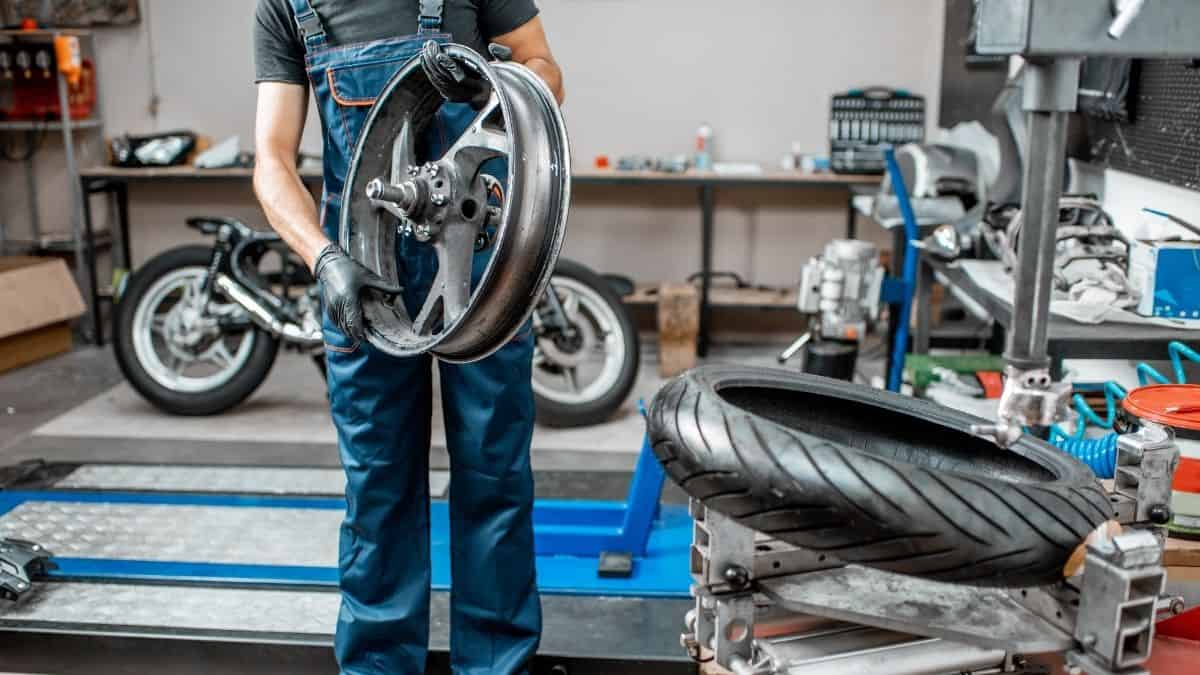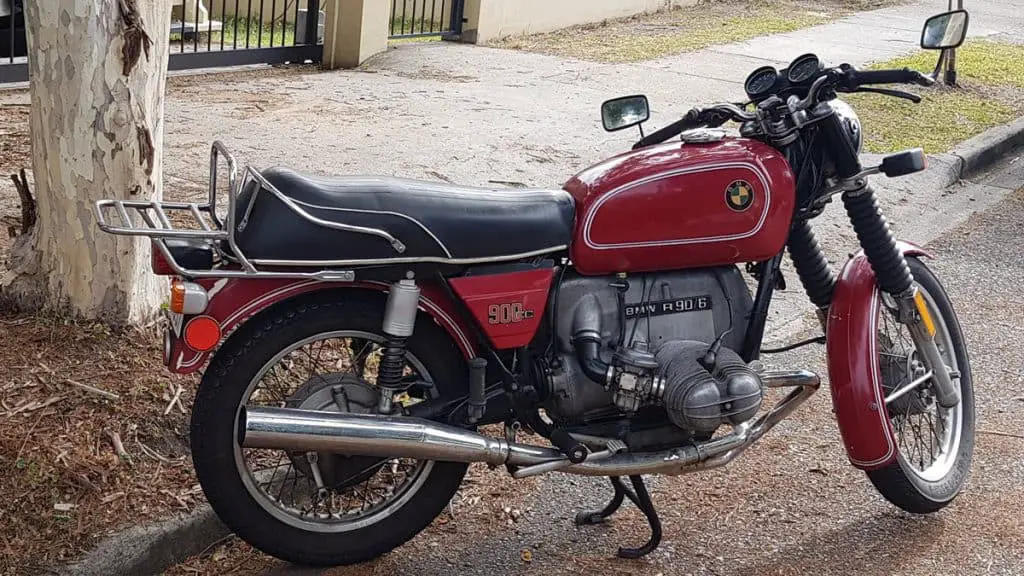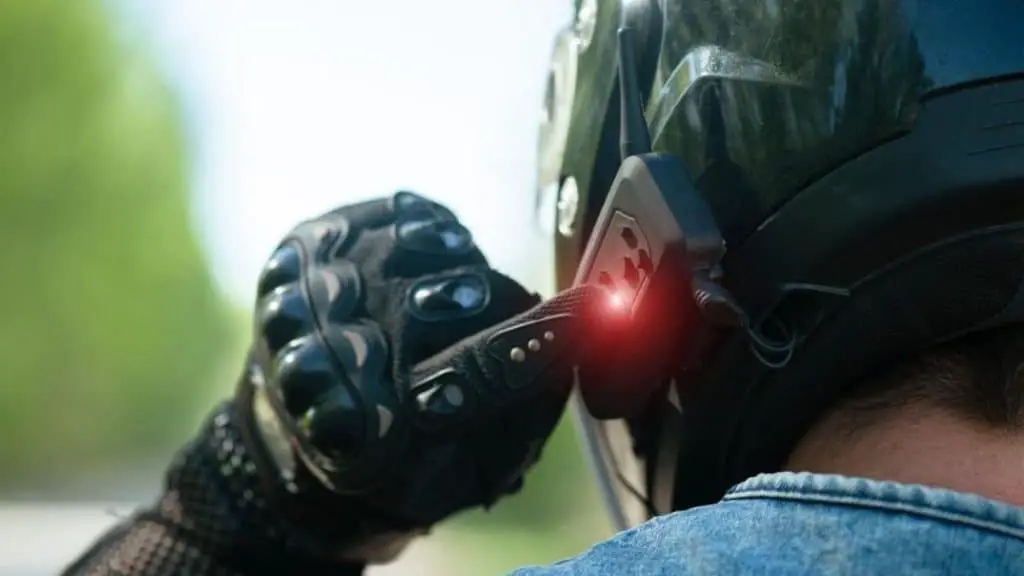Using Front Motorcycle Tire on the Rear (Change or Switch?)
Here’s one common question you will find on any motorcycle message board.
Can you run a front motorcycle tire on the rear?
Now that’s a wrong question to ask.
Technically, you can run a front motorcycle tire on the rear if the size matches.
Here’s the right question – is running a front motorcycle tire on rear safe AND good for performance?
Not at all!
The same goes for using rear tires on the front.
There are reasons why motorcycle tires are designed specifically for front and rear use!
Time to dig a little deeper.
⚠️ This might get a bit technical so best put on your thinking caps.
The Difference Between Motorcycle Rear and Front Tires
Before thinking of interchanging the front and rear tires, you need to understand the exact functionality of each.
The fact is, tires work together with the wheels, the swingarm, the forks, and other components to form a complete system. A minor change in the tires can impact the entire motorcycle.
If you have spared a look or two at the tires of your motorcycle, you will notice that they are different.
The front tires are larger in diameter but narrower. Their tread pattern is less aggressive as well.
The reason is, the front tires take the brunt of the braking forces (almost 80%). They also withstand the initial impact of any bumps, potholes, and other road irregularities.
The front tire also plays an important role in steering and handling the bike. With a thinner tire profile turning the motorcycle gets easier and it also helps in improving stability on rough roads.

On the other hand, the rear tires are smaller in diameter but wider. The tread pattern is more aggressive as well.
Why so?
Firstly, the power from the engine is directly transmitted to the rear tire through the sprocket and chain. Besides, it also carries most of the bike’s weight and that of the rider. (Notice, it’s right under the engine.)
The wide surface area allows it to carry heavier loads and withstand the additional forces of acceleration when you rev it up. It also generates more traction to provide better stability.
Here’s another common question – why do motorcycle front and rear tires have opposite tread patterns?
(I know, I know. More technical details. Ugh…)
As I said, the front tire has the braking force acting on it while the rear has to handle the accelerating forces. But the directions of these two acting forces are opposite.
And that’s the main reason why the tires have opposite tread patterns.
With the grooves aligned with the forces, designers minimize the tread wear.
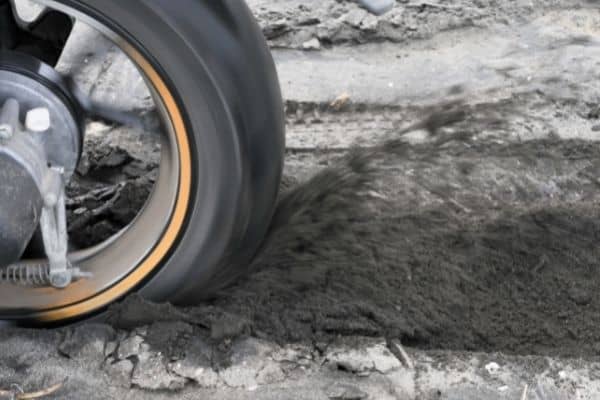
Another reason why you can’t use front and rear tires interchangeably is their directions of rotation are different. This is because there’s a difference in tread patterns.
The tread design ensures that the braking force, as well as the traction, is not compromised on a wet surface.
Actually, tread design is a complex art of balancing various factors like ride angle, lean angle, and estimated loads. I won’t go into all that here.
But here’s something interesting…
Head out for a ride right after a spell of rain. You will find the rear and front tires directing the groundwater in two different directions.
This is because of the difference in the direction of the tread patterns in the two tires.
Both the treads displace water to maximize the tire and ground contact. But the direction of water displacement is based on the different forces acting on the front and rear tires.
And water dispersing is very important for stability in wet conditions. If you have ever experienced hydroplaning, you know what I am talking about.
Note, the design considerations are different with racing tires. Race tracks are very well maintained, so racing tires hardly have any tread pattern.
See the difference between the two tires?
In essence, a lot of thought goes into the design of the front and rear tires to make a bike perform at its best.
Using The Front Tire on the Rear on a Motorcycle
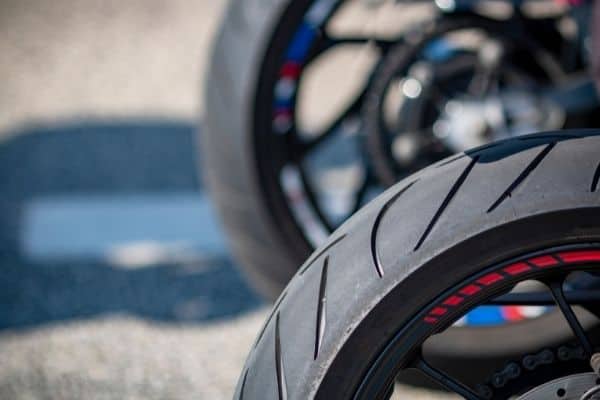
Imagine placing the front tire on the rear.
Now that you know the differences between the two, it’s pretty obvious once you think about it.
The first thing is, the sizes will be different. And even if they are of the same size, it’s a bad idea.
Any deviation from the formula set by the manufacturer can affect handling and ride safety.
The thinner profile of the front tire will not be able to handle the heavier loads and high acceleration forces acting on the rear wheel. Besides, the stability of the bike will also be affected.
Let’s come back to the grooves. The grooves in the rear tires are designed to push water towards the sidewalls. This maximizes the grip on a wet surface.
By using a front tire on the rear, you will risk your skin on a wet surface.
Even if you manage to avoid the risks, the tire simply won’t last long.
In short, a front tire is designed specifically for the front wheel and nowhere else.
What if you use a tire specified for rear use on the front?
It won’t absorb the impacts effectively and the bike’s handling will suffer. The effects can be even worse than using the front tire on the rear.
But you can do that in a car, right?
Yes, but there’s a lot of difference between the design and handling of cars and motorcycles.
(Do you think your car will lean the same way as your bike while negotiating a sharp bend?)

The forces acting on the car’s tires will be completely different. So, the profile, construction, and compounds used for car tire making are also different.
Obviously, naysayers might point out that this is just a marketing ploy. That’s not the way people used to ride motorcycles a few decades ago.
If you could ride back to the 1900s, you will find most motorcycles having similar tires. (Don’t do that. You won’t find my blog in that era😏)
But motorcycle design evolved with time. Modern motorcycles and tires are made with a lot more attention to detail and performance.
Still, you may not want to take advantage of technology that provides better safety and performance. The choice is yours.
In reality, you can interchange the front and rear tires in a motorcycle and get away with it. But it can be a serious safety hazard that you don’t want to risk.
Mix and match work fine when you’re choosing outfits. But motorcycles are fine-tuned machines.
If the manufacturer has marked a tire “front only” they have a specific reason for that. After all, they spent hours and hours designing the right tires for optimized performance. No point in undoing that.
Note, the best motorcycle tires come with a direction of rotation imprinted on the side walls. While installing make sure they rotate in the specified direction when the motorcycle is moving forward.
Can You Have Two Different Tires On A Motorcycle?
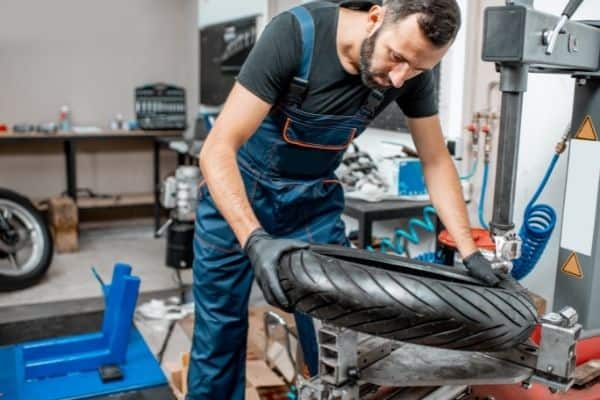
I have to confess, I‘m a rider with a safety-first approach. (There’s no hurry to meet the creator, right?)
Using tires that don’t match the manufacturers’ specifications is inviting trouble. The two tires are tested together and are designed to work together for the best performance.
And let’s admit it. You don’t know the physics or mechanics behind tire design.
Using different tires can not only damage the motorcycle but can also affect the weight distribution and maneuvering of the bike. In fact, you can’t be sure how it will affect the handling.
Larger tires will rub against the frame and wiring and damage the bike. Smaller tires might fail to sustain the loads and burst.
And losing control of a motorcycle on a freeway…
Really, do I need to say more?
Heck, there are many who love the idea of using a car tire on the rear. (Perhaps you can switch back to motorcycle tires the day you are not in a mood to crash.)
Honestly, I respect people who think differently.
Doing that can be fun during a normal ride. But during a demanding situation, those tires will not respond the way you want them.
Fine, you’re a hardcore motophile and don’t mind the risks.
But consider this…
In the event of a crash, will you get insurance coverage if you have replaced your original tires with tires of the wrong specification?
What if a bystander injured in the crash sues you for using the wrong tires?
Now that’s NOT a situation you want to get into.
Sure, the world needs creative thinkers. But casual experimentation by disregarding the experts isn’t worth the risk!
Frequently Asked Questions
Are the front and rear motorcycle tires the same?
Front and rear motorcycle tires aren’t the same as they withstand different forces. The front tire is larger but thinner. The tread patterns of the two are also different.
Can you put a front tire on the back?
Putting a tire specified for “front use” in the rear isn’t a good idea. It can affect stability as well as the performance of the bike. The tire might even fail or burst leading to an accident.
Do the front and rear motorcycle tires have to match?
In most performance motorcycles, the front and rear tires don’t match. Each tire is designed based on the exact functionality and to optimize the performance of the motorcycle.

